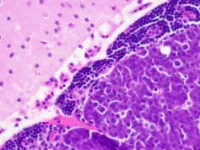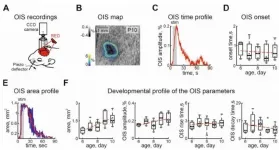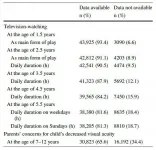Research shows how people changed their behavior in response to COVID-19 guidance
National guidelines overruled state and local pandemic policies
2021-05-20
(Press-News.org) When the United States issued national stay-at-home guidelines in March 2020 in response to the COVID-19 pandemic, mobility across the country dropped significantly. New research from the Harvard John A. Paulson School of Engineering and Applied Sciences (SEAS) demonstrates that people may be inclined to change their behavior in response to national guidelines, more than state and local policies.
"When the next pandemic hits, we need to know what kind of policies are going to have the biggest impact on human behavior and health," said Marianna Linz, Assistant Professor of Environmental Science and Engineering and of Earth and Planetary Sciences at SEAS and senior author of the paper. "While specific, local policies based on community spread may make the most sense, we found that people seem to change their behavior more in response to national guidelines. This suggests that clear national guidelines, at least in the beginning, are going to have the biggest impact on public health."
The research is published in the Proceedings of the National Academy of Sciences (PNAS).
The researchers used cell phone mobility data collected by Google and Unacast, a location data company, to study how far people traveled and how many people they encountered between February 24 to May 22 and June 1 to August 28.
The researchers found that in most states, grocery store and pharmacy visits peaked within a few days of March 13, the day the White House declared a state of emergency and banned travel from 26 European countries. The following weekend, after the release of national stay at home guidelines and school closures, people across the country started to stay put although most states then had only a few hundred known COVID-19 cases.
"Although many states delayed implementing stay-at-home orders, there was near uniformity in behavior at the beginning of quarantine across states," said Yihan Wu '22, an undergraduate researcher in Linz's Lab and first author of the paper. "It was really striking to see just how consistent behavior was at that time."
Similarly, when the national stay-at-home advisory ended on May 1st, there was a uniform rise in mobility across the country, even though locally many schools and offices remained closed.
"Despite different local stay-at-home orders and state reopening timelines, we see encounters increasing in a coherent way nationwide when the national guidelines expired," said Todd Mooring, a postdoctoral fellow at Harvard and co-author of the study.
The researchers also looked at how weather impacted mobility and encounters during the quarantine period. Despite news stories featuring crowded beaches and packed pool parties, the data did not show systematic increases in close encounters on nice days.
"We found that while visits to parks increased on nice days during the shutdown, most people were still being cautious and avoiding encounters with other people during the national stay-at-home period," said Wu.
"While the response to COVID-19 became increasingly politicized over time, that wasn't the case in the beginning," said Linz. "Our results suggest that coherent national guidance could help contain virus transmission in the future. COVID-19 may be too politicized now, but this result will be useful to future pandemic planning."
INFORMATION:
ELSE PRESS RELEASES FROM THIS DATE:
2021-05-20
Two experimental drug approaches that target vulnerabilities in cancer cell metabolism may extend survival and enhance the effectiveness of standard chemotherapies for a highly aggressive type of pediatric brain cancer.
The findings were reported by Johns Hopkins Kimmel Cancer Center researchers in two published studies.
Medulloblastoma is the most common malignant pediatric brain tumor. A subset of patients with tumors known as Group 3 MYC-amplified medulloblastoma have an overall survival rate of less than 25%. In these patients, the cancer-promoting MYC oncogene drives cancer cell growth by altering cancer cell metabolism. Cancer cells use energy in ways that are different from normal cells, ...
2021-05-20
Researchers in China, Japan, and Singapore were able to resume research much quicker than their counterparts in the US and Europe after the first covid lockdowns, results of a new international survey suggest.
Published 'Open Access' in the peer-reviewed journal Science and Technology of Advanced Materials, the findings of the 'Survey on the effects of the COVID-19 pandemic on research activities of materials scientists', which also included a series of podcasts with eminent experts, highlight how severe the impact of lockdowns affected researchers internationally.
33% of respondents had to shut down all equipment.
The outcomes were not uniform internationally however, as whilst labs in the UK and parts of the USA, Spain, and India were not accessible ...
2021-05-20
DURHAM, N.C. -- Researchers have discovered a new coronavirus, found in a child with pneumonia in Malaysia in 2018, that appears to have jumped from dog to human.
If confirmed as a pathogen, the novel canine-like coronavirus could represent the eighth unique coronavirus known to cause disease in humans. The discovery also suggests coronaviruses are being transmitted from animals to humans more commonly than was previously thought.
"How common this virus is, and whether it can be transmitted efficiently from dogs to humans or between humans, nobody knows," said Gregory Gray, M.D., a professor of medicine, ...
2021-05-20
Study lead, Research Associate of the Neurobiology Lab Marat Minlebaev explains, "Our brain is a complex mechanism, and it's important to understand how it works. If we understand how our brain functions, we can put forth new treatment methodologies or prevent pathologies, both congenital and acquired."
A number of techniques were used to undertake the research, so, apart from biologists, other scientists were also invited to partake.
"Fourth year students Viktoria Shumkova and Violetta Sitdikova conducted experiments and analyzed their results," says Minlebaev. "To implement the idea, new software was ...
2021-05-20
Researchers from Russia and Germany have created a genome-wide atlas of developmental alternative splicing changes of seven organs in six mammal species and chicken.
The research was published in the journal Nature Genetics.
As the protein encoding RNA matures in eukaryotes, it gets spliced, with some parts cut out and the remaining fragments stitched together. Alternative splicing means that the same RNA fragment can either be cut out from or kept within the mature RNA. In this case, one gene can encode several RNAs and, therefore, several proteins. Although alternative splicing is known to be essential for many tissues to develop and function properly and its various disorders may cause health problems, ...
2021-05-20
It is ingrained in parents to curtail the hours their children spend in front of the television. Anecdotal evidence suggests that prolonged viewing of television and use of smart gadgets during early years can adversely affect a child's eyesight and behavioral development. However, there is little scientific evidence to support such observations on the effects of excessive television exposure on children's visual acuity. Now, Professor MATSUO Toshihiko (M.D., Ph.D.) and Professor YORIFUJI Takashi (M.D., Ph.D.) from Okayama University describe how such exposure can indeed have detrimental effects on children's eyesight during later years.
The researchers used a national database of the Japan Government, based on the annual survey of all children born in the certain period of the ...
2021-05-20
Nerves release a protein at the injury site that attracts growing nerve fibers and thus keeps them entrapped there. This prevents them from growing in the right direction to bridge the injury. The research team headed by Professor Dietmar Fischer reports in the journal Proceedings of the National Academy of Sciences (PNAS) from 25. May 2021.
There must be another cause
Three main causes for the inability of injured nerves of the central nervous system, or CNS, to regenerate have been known to date: the insufficient activation of a regeneration program in injured nerve cells that stimulates the growth of fibers, so-called axons; the formation of a scar at the site ...
2021-05-20
TROY, N.Y. -- Heart disease and cancer are the leading causes of death in the United States, and it's increasingly understood that they share common risk factors, including tobacco use, diet, blood pressure, and obesity. Thus, a diagnostic tool that could screen for cardiovascular disease while a patient is already being screened for cancer, has the potential to expedite a diagnosis, accelerate treatment, and improve patient outcomes.
In research published today in Nature Communications, a team of engineers from Rensselaer Polytechnic Institute and clinicians from Massachusetts General Hospital developed a deep learning algorithm that can help assess a patient's risk of cardiovascular disease ...
2021-05-20
Herndon, Va. (May 20, 2021) - The international journal Risk Analysis has published a timely special issue for May 2021, "Global Systemic Risk and Resilience for Novel Coronavirus and COVID-19." Featuring 11 papers written for this issue over the past year, the collection represents a sampling of insights and viewpoints from scholars across risk sciences and resilience analytics to guide decision-making and operations related to the COVID-19 pandemic.
The 11 papers address the breadth of risk sciences represented by the Society for Risk Analysis (SRA), including risk perception, risk and resilience, human health and ...
2021-05-20
A University of Otago study has revealed how earthquake upheaval has affected New Zealand's coastal species.
Lead author Dr Felix Vaux, of the Department of Zoology, says earthquakes are typically considered devastating events for people and the environment, but the positive opportunities that they can create for wildlife are often overlooked.
For the Marsden-funded study, published in Journal of Phycology, the researchers sequenced DNA from 288 rimurapa/bull-kelp plants from 28 places across central New Zealand.
"All specimens from the North Island were expected to be the species Durvillaea antarctica, but unexpectedly 10 samples from four sites were ...
LAST 30 PRESS RELEASES:
[Press-News.org] Research shows how people changed their behavior in response to COVID-19 guidance
National guidelines overruled state and local pandemic policies



